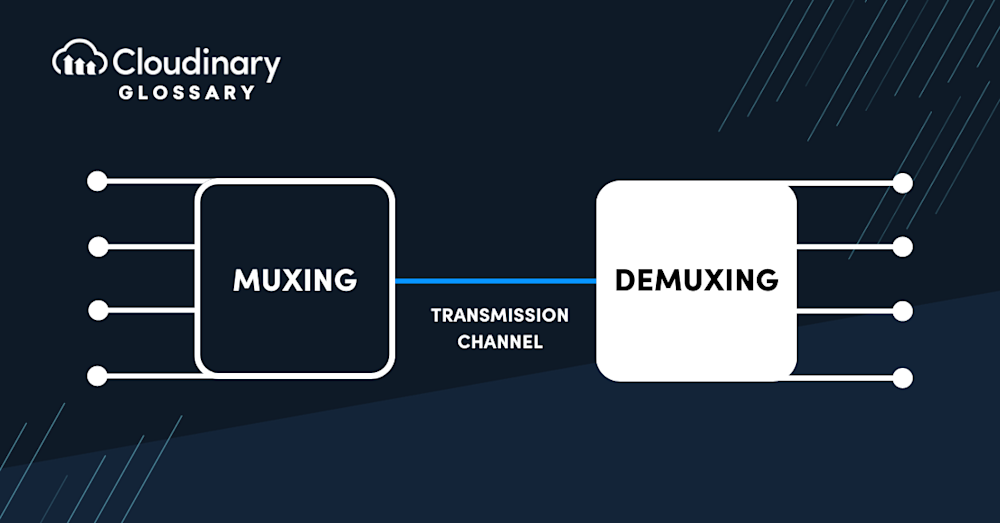What Is Muxing?
At its simplest, muxing or “multiplexing” functions as a traffic director in digital media. It blends numerous types of media data – think video, audio, or subtitles – into a single, streamlined file known as a container. This container – which can vary in format, including MP4, AVI, or MKV – acts almost like a digital suitcase, holding all its parts together and ensuring they’re synchronized for playback.
How Does Muxing Work?
To answer the question “How does muxing work?”, imagine a busy intersection in a city. Without a traffic light or someone to manage the flow, chaos ensues. Now consider the traffic light as the multiplexer (muxer), controlling diverse data streams and presenting a harmonious output. In the realm of media, the muxer takes different raw data streams – video, audio, subtitles (often decoupled in demuxing) – and marries them into a single container file for synchronized consumption.
The process, while intricate, is essentially about time management. Using timestamps attached to the raw streams, the muxer coordinates which data from each stream needs to be presented at any given moment. It’s similar to a conductor leading an orchestra to ensure all instruments play in harmony. If one element is out of sync, it undermines the entire performance. Similarly, when muxing is done right, you achieve seamless playback where audio aligns with the video, subtitles match dialogue, and everything comes together to deliver a flawless media experience.
What is Muxing Used For?
Muxing serves as a foundational concept and integral tool within the digital media industry that impacts diverse facets of media consumption and storage. Its utility can be broken down into several key applications:
- Streamlined Media Playback – Muxing allows video, audio, and subtitle streams to synchronize seamlessly, delivering a cohesive viewing experience.
- Format Transitions – Muxing facilitates changing media from one digital container to another, such as from MOV to MP4, to support different platform requirements.
- Efficient Storage and Transport – By combining multiple streams into a single file, muxing makes digital media more compact, simplifying storage and facilitating easier transmission.
- Flexible Media Customization – With muxing, users can add, remove, or modify elements like subtitles, commentary tracks, or alternative audio languages to tailor the media file to suit specific needs.
With its dynamic range of uses, it’s clear that muxing is more than technical jargon; it’s essential for delivering and customizing media to cater to global audiences’ diverse needs.
The Different Types of Muxing
Time-Division Multiplexing (TDM) operates by dividing available bandwidth into time slots. In this method, different data streams are encoded and transmitted in predetermined time intervals, ensuring coordinated and simultaneous arrival at the destination. This approach is commonly employed in applications that need a regularly scheduled and fixed communication pattern, such as telecommunication systems or digital voice signals.
Time-Division Multiplexing (TDM)
Time-Division Multiplexing (TDM) operates by dividing available bandwidth into time slots. In this method, different data streams are encoded and transmitted in predetermined time intervals, ensuring coordinated and simultaneous arrival at the destination. This approach is commonly employed in applications that need a regularly scheduled and fixed communication pattern, such as telecommunication systems or digital voice signals.
Frequency-Division Multiplexing (FDM)
In Frequency-Division Multiplexing (FDM), data streams don’t share time slots but operate on separate frequency bands. Imagine radio channels – each occupies a unique frequency to avoid interference, with data transmission happening simultaneously across these channels. FDM is generally used in scenarios where multiple communication channels, such as radio transmissions or analog cable television, need to coexist without interference.
Statistical Multiplexing
Lastly, Statistical Multiplexing (StatMux) introduces a more dynamic and resource-efficient method. StatMux enables multiplexing of variable bit rate data streams by allocating resources based on real-time requirements instead of fixed intervals or bands. This technique is particularly useful for simultaneously accommodating varying data stream sizes or compressions. Typical applications include digital video broadcasting or carrying multiple high-quality video streams over a single network without compromising video quality.
Each of these three types of muxing showcases a specific approach to handling data stream synchronization and resource management, and each is designed to cater to a diverse set of media or communication requirements.
Final Thoughts
As we’ve journeyed through the world of muxing, a key takeaway is that multiplexing is essential for efficient, customizable, and versatile media experiences. From the core principles of muxing to different types of multiplexing, this knowledge will empower developers and technical professionals to engage with digital media management more effectively. Armed with clarity and insight on muxing, you’ll be better equipped to handle complex media environments, whether managing multiple audiovisual streams or optimizing your content organization and storage.
Don’t let the complexity of digital media management overwhelm you – let Cloudinary’s end-to-end solutions lend a helping hand. Cloudinary caters to a wide array of media handling needs, offering seamless media management solutions to enhance productivity and efficiency while ensuring top-notch quality. It’s time to embrace the potential of muxing and level up your media workflows.
Discover how Cloudinary can redefine your digital media experience and take the first step towards streamlined, effortless multimedia management.
Check Out Our Tools That You May Find Useful:



